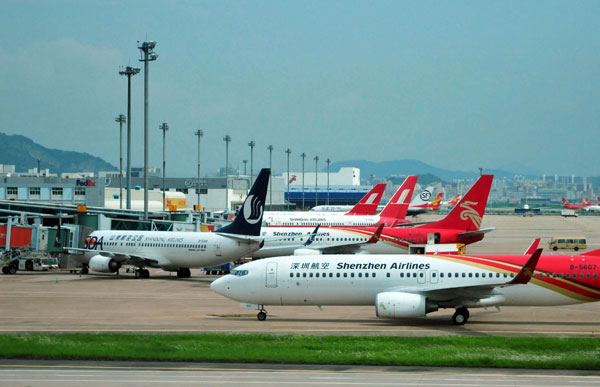The Pearl River Delta is one of the most congested parts of China's airspace, with five major airports in the region, and none of them more than 200 kilometers apart from each other.
That's a rare situation in the world, industry insiders said.
Yet, the region has a new runway under construction, another runway approved, and a new airport under consideration.
Civil aviation experts worried that the soon-to-be-added facilities will worsen congestion problems, given that only a small part of the Chinese airspace is for civil use, and called for a reform of the airspace management mechanism.
 |
|
Airplanes taxi at Shenzhen Bao'an International Airport in 2011. Zhang Bin / for China Daily |
The new runway under construction at Guangzhou Baiyun International Airport came after the National Development and Reform Commission approved the expansion plans in July.
The expansion project - which also includes plans for a new terminal and two more runways - aims to prepare the facility to handle 80 million passengers a year by 2020, up from 45 million passengers last year.
Guangzhou has been appointed as one of the country's three main international aviation gateways, according to the country's 12th Five-Year Plan (2011-15). The capital city of South China's Guangdong province will mainly connect Oceania and Southeast Asia.
Guangzhou's plans have clearly put pressure on Hong Kong International Airport, currently the busiest airport in the region. It handled 54 million passengers and 3.97 million tons of cargo last year.
As a way to secure the airport's leading position in the region, the Hong Kong government has this year agreed in principle to a third runway, though some industry insiders believe that the runway won't be ready for use until 2023.
Meanwhile, media reports said that Guangzhou is mulling a new airport in the Nansha New Area, a State-level development zone.
The city's leadership believes that Nansha needs an airport to increase its appeal to investors, said Ouyang Jie, a professor at the Civil Aviation University of China who specializes in airport studies.
"Otherwise, air passengers, upon their arrival at Guangzhou Baiyun airport, will have to travel through crowded downtown Guangzhou in order to get to Nansha, which is situated at the southernmost edge of Guangzhou," he said.
City officials also believe that because Nansha is at the geographical center of the Pearl River Delta region, the new airport will be able to cover the population of the whole region, which the Baiyun airport, located at the north of city, is unable to do, Ouyang added.
Experts are not optimistic about the future of a second airport in Guangzhou, though.
"If the military and the local government cannot reach a consensus and expand the airspace for civil use, the second-airport project cannot possibly be approved," said Li Kun, a researcher with the Comprehensive Transport Institute, which is affiliated with the National Development and Reform Commission.
Congested airspace
The region's sky has been so severely congested that the International Air Transport Association has said that the situation in the Pearl River Delta is one of the top three global air traffic control problems.
In the past few years, even though new runways were added, they failed to fuel traffic growth because of the congestion problems.
The congestion also increases fuel consumption. Researchers at the Aviation Policy and Research Center of the Chinese University of Hong Kong estimated that the congestion costs more than HK$1 billion ($130 million) a year in fuel alone.
The most direct cause behind the congestion problems is that four of the five airports - in Shenzhen, Zhuhai, Hong Kong and Macao - are all packed at the mouth of the Pearl River, forcing planes to make detours to ensure safe take-offs and landings, professor Ouyang said.
The Guangzhou Baiyun airport is a little up in the north, but flights leaving the four airports for northern destinations all have to fly over Baiyun airport, adding to the problems there, he said.
Many people wonder why the airports were built so close to each other. Ouyang said that is due to complicated factors, involving "historical reasons".
"Shenzhen, a pioneer of China's reform and opening-up efforts, which started more than 30 years ago, tried to cooperate with the Hong Kong airport, but the different social systems and border policies made it impossible," he said.
Hong Kong returned to China in 1997. Shenzhen, unable to wait for an airport to boost economic development, built an airport that opened in 1991.
It was a similar case in Zhuhai, which opened its airport in 1995, though it had mulled cooperating with Macao, which did not return to China until 1999, he said.
Ouyang believes that the only way for the five airports to survive in the region is if they have different functions, like the five airports in the Greater London area.
Zhuhai airport has the weakest performance among the five airports in the Pearl River Delta, as its planned scale is found to have surpassed the actual needs of the city's population of 600,000.
A blessing in disguise for Zhuhai is that its redundant capacity has allowed it to host a biennial air show and develop general aviation flights, which refers to all civil aviation activities except for scheduled flights, he said.
However, the competition between Guangzhou and Shenzhen airports needs more attention, he said.
As the Hong Kong airport is an international air hub and the Macao airport aims to attract leisure tourists, intense competition exists mainly between Guangzhou and Shenzhen, with both seeking development in passengers and cargo transportation, he said.
Coordination between the two airports will be difficult, since the two are run by two separate and independent corporations, he said.
